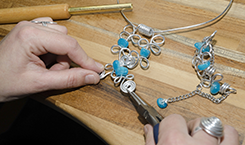Level 3 Diploma Jewellery and Silverware Manufacturing

SQA code: GJ4V57
Ofqual code: 601/3128/7
Total Qualification Time: 805NN
Guided Learning Hours: 565
Credit value: 81
This qualification has been developed in partnership with Creative & Cultural Skills and provides learners with a high level of understanding and proficiency in all stages of jewellery manufacture to a commercial standard.
The two pathways of jewellery manufacture and silversmithing provide an opportunity to develop and specialise in more complex production and design techniques.
The Diploma will develop knowledge and skills in areas such as producing precious metal objects from detailed drawings and specifications; marking out and measuring materials; using mechanical methods to join precious metal components; producing tools and jigs; and applying concepts of metallurgy for use in the manufacture of precious metal objects.
This qualification may be available through employers, training providers and colleges in England.
Use the tabs below to open each section individually. Alternatively you can show all the sections.
Rationale and purpose of this qualification
Its primary purpose is to confirm the learner's occupational competence as a jeweller or silverware manufacturer. As a work-related, competence-based qualification it provides confirmation to employers, that the learner has the skills and knowledge needed to meet the nationally recognised standard to carry out the role.
Learners who achieve this qualification will have a high level understanding and proficiency in all stages of the jewellery or silverware manufacturing process and will be able to work independently, with confidence and consistency.
Learners can use it to gain employment, to progress in the industry, or to work towards another qualification (see Progression).
Objectives
The qualification is designed to meet the following objectives:
- supporting a role in the workplace
- confirming knowledge, understanding and skills
What does this qualification cover?
As this is a competence-based qualification, learners will be acquiring the knowledge and skills required through either on-the-job experience or in a learning environment.
To achieve the whole qualification, learners need a minimum of 81 credits. They must complete six mandatory units (credit value 41) then three mandatory units (credit value 34) and one optional unit (credit value 6) from either the jewellery or silversmithing pathways. See the qualification structure for more information.
Who is this qualification for?
This qualification is suitable for:
- learners who already have a knowledge of jewellery making and design drawing
- learners who have completed a qualification in a relevant discipline at Level 2 Jewellery Manufacturing
- people in employment who wish to enhance their career prospects
- individuals who wish to start their own business
Entry
Entry to the qualification is at the discretion of the centre.
This qualification is mainly taken by individuals employed as jewellers or silverware manufacturers.
Apprenticeships
This qualification is a mandatory component in the Jewellery, Silversmithing and Allied Trades Apprenticeship in England (as detailed in SASE).
Progression
Learners may progress from the Level 3 Diploma in Jewellery and Silverware Manufacturing to a Level 4 Diploma in Jewellery and Silverware Manufacturing.
This qualification can lead to progression within the jewellery and silverware manufacturing industry.
Deliver this qualification
Thinking of working with us?
- Our 3 step approval process
- Become an SQA approved centre
- Charges and Fees of SQA Qualifications in England and Wales
Existing customer?
Where can you take this course
Qualification structure
The qualification requires the learner to complete six mandatory units (credit value 41) plus three mandatory units (credit value 34) and one optional unit (credit value 6) from either the jewellery or silversmithing pathways.
Please refer to the qualification structure (110 KB) for more information.
